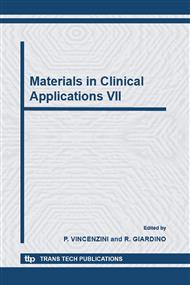[1]
H. Kawahara, A. Yamagami, K. Nakagawa, S. Komatsu. Bioceram Porous Implant. Ishiyaku-Shuppan Japan (1989), 2: pp.2-42.
Google Scholar
[2]
K. Ozaki, M. Toda, H. Takeuchi. et al. A single alumina screw type dental implant (Bioceram), Statistical investigation of 23-year-long clinical cases. J Jpn Soc Oral Implantol (1999), 12: pp.146-147.
Google Scholar
[3]
A. Yamagami, H. Kawahara. Shingle crystal porous alumina (sapphire) for dental implant. In: Wise D (ed). Encyclopedic Handbook of Biomaterials and Bioengineering. Vol 2: Applications. New York: Marcel Dekker (1995), pp.1617-1637.
Google Scholar
[4]
A. Yamagami, S. Kotera, H. Kawahara. Studies on a porous alumina dental implant reinforced with single-crystal alumina: Animal experiments and human clinical applications, Quantitative characterization and performance of porous implant for hard tissue applications, ASTM STP 953(J.E. (ed. ) Lemon,: American society for testing and materials). Philadelphia (1987).
DOI: 10.1520/stp25250s
Google Scholar
[5]
A. Yamagami, S. Kotera, Y. Ehara, Y. Nishio. Porous alumina for free-standing implants. Part 1: Implant design and in vivo animal studies. J Prosthet Dent (1988), 59: pp.689-695.
DOI: 10.1016/0022-3913(88)90384-8
Google Scholar
[6]
R. Adell, U. Lekholm, B. Rockler. Branemalk P-1. A 15-year study of osseointegrated implants in the treatment of the edentulous jaw. Int J Oral Surg (1981), 10: pp.387-416.
DOI: 10.1016/s0300-9785(81)80077-4
Google Scholar
[7]
J. Roos, L. Sennerby, U. Lekholm, T. Jemt, K. Grondahl, T. Albrektsson. A qualitative and quantitative method for evaluating implant success: A 5-year retrospective analysis of the Branemark implant. Int J Oral Maxillofac Implants (1997).
Google Scholar
[8]
T. Albrektsson, P. Strand, W. Becker, et al. Histologic studies of failed dental implants: A retrieval analysis of 4 different oral implant designs. Clin Mater (1992), 10: pp.225-232.
DOI: 10.1016/0267-6605(92)90015-l
Google Scholar
[9]
F. Grizon, E. Aguado, G. Hure, MF. Basle, D. Chappard. Enhanced bone integration of implants with increased surface roughness: A long-term study in the sheep. J Dent (2002), 30: pp.195-203.
DOI: 10.1016/s0300-5712(02)00018-0
Google Scholar
[10]
AB Jr. Novaes, SL. Souza, PT. de Oliveira, AM. Sonza. Histomorphometric analysis of the bone-implant contact obtained with 4 different implant surface treatments placed side by side in the dog mandible. Int J Oral Maxillofac Implants (2002).
DOI: 10.1097/00008505-200211040-00051
Google Scholar
[11]
L. Carlsson, T. Rostlund, B. Albrektsson, T. Albreksson. Removal torques for polished and rough titanium implants. Int J Oral Maxillofac Implants (1988), 3: pp.21-24.
Google Scholar
[12]
KA. Thomas, SD. Cook. An evaluation of variables influencing implant fixation by direct bone apposition. J Biomed Mater Res (1985), 19: pp.875-901.
DOI: 10.1002/jbm.820190802
Google Scholar
[13]
D. Buser, RK. Schenk, S. Steinemann, JP. Fiorellini, CH. Fox, H. Stich. Infuluence of surface characteristics on bone integration of titanium implants. A histomorphometric study in miniature pigs. J Biomed Mater Res (1991), 25: pp.889-902.
DOI: 10.1002/jbm.820250708
Google Scholar
[14]
S. Kanagaraja, A. Wennerberg, C. Eriksson, H. Nygren. Cellular reactions and bone apposition to titanium surfaces with different surface roughness and oxide thickness cleaned by oxidation. Biomaterials (2001), 22: pp.1809-1818.
DOI: 10.1016/s0142-9612(00)00362-8
Google Scholar
[15]
DD. D'Lima, SM. Lemperle, PC. Chen, RE. Holmes, CW Jr. Colwell. Bone response to implant surface morphology. J Arthroplasty (1998), 13: pp.928-934.
DOI: 10.1016/s0883-5403(98)90201-7
Google Scholar


